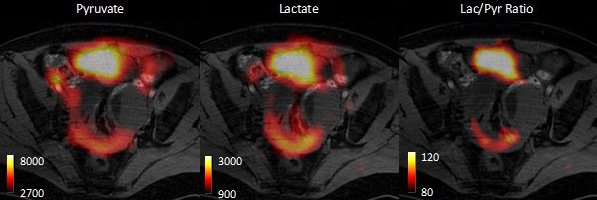
Image credit: Kevin Brindle/ University of Cambridge
News • Hyperpolarised carbon-13 imaging
Metabolic MRI imaging distinguishes ovarian cancer subtypes
Imaging technique allows rapid assessment of ovarian cancer subtypes and their response to treatment
The technique, called hyperpolarised carbon-13 (13C) imaging, can increase the detected signal in an MRI scanner by more than 10,000 times. Scientists have found that the technique can distinguish between two different subtypes of ovarian cancer, to reveal their sensitivities to treatment. They used it to look at patient-derived cell models that closely mimic the behaviour of human high grade serous ovarian cancer, the most common lethal form of the disease. The technique clearly shows whether a tumour is sensitive or resistant to Carboplatin, one of the standard first-line chemotherapy treatments for ovarian cancer. This will enable oncologists to predict how well a patient will respond to treatment, and to see how well the treatment is working within the first 48 hours.

Image source: University of Cambridge
Different forms of ovarian cancer respond differently to drug treatments. With current tests, patients typically wait for weeks or months to find out whether their cancer is responding to treatment. The rapid feedback provided by this new technique will help oncologists to adjust and personalise treatment for each patient within days. The study compared the hyperpolarised imaging technique with results from Positron Emission Tomography (PET) scans, which are already widely used in clinical practice. The results shows that PET did not pick up the metabolic differences between different tumour subtypes, so could not predict the type of tumour present.
“This technique tells us how aggressive an ovarian cancer tumour is, and could allow doctors to assess multiple tumours in a patient to give a more holistic assessment of disease prognosis so the most appropriate treatment can be selected,” said Professor Kevin Brindle in the University of Cambridge’s Department of Biochemistry, senior author of the report.
Ovarian cancer patients often have multiple tumours spread throughout their abdomen. It isn’t possible to take biopsies of all of them, and they may be of different subtypes that respond differently to treatment. MRI is non-invasive, and the hyperpolarised imaging technique will allow oncologists to look at all the tumours at once.
One of the questions cancer patients ask most often is whether their treatment is working. If oncologists can speed their patients onto the best treatment, then it’s clearly of benefit
Kevin Brindle
Brindle added: “We can image a tumour pre-treatment to predict how likely it is to respond, and then we can image again immediately after treatment to confirm whether it has indeed responded. This will help doctors to select the most appropriate treatment for each patient and adjust this as necessary. One of the questions cancer patients ask most often is whether their treatment is working. If oncologists can speed their patients onto the best treatment, then it’s clearly of benefit.”
The next step is to trial the technique in ovarian cancer patients, which the scientists anticipate within the next few years.
Hyperpolarised carbon-13 imaging uses an injectable solution containing a ‘labelled’ form of the naturally occurring molecule pyruvate. The pyruvate enters the cells of the body, and the scan shows the rate at which it is broken down – or metabolised – into a molecule called lactate. The rate of this metabolism reveals the tumour subtype and thus its sensitivity to treatment.
This study adds to the evidence for the value of the hyperpolarised carbon-13 imaging technique for wider clinical use. Brindle, who also works at the Cancer Research UK Cambridge Institute, has been developing this imaging technique to investigate different cancers for the last two decades, including breast, prostate and glioblastoma - a common and aggressive type of brain tumour. Glioblastoma also shows different subtypes that vary in their metabolism, which can be imaged to predict their response to treatment. The first clinical study in Cambridge, which was published in 2020, was in breast cancer patients.
Each year about 7,500 women in the UK are diagnosed with ovarian cancer – around 5,000 of these will have the most aggressive form of the disease, called high-grade serous ovarian cancer (HGSOC). The cure rate for all forms of ovarian cancer is very low and currently only 43% of women in England survive five years beyond diagnosis. Symptoms can easily be missed, allowing the disease to spread before a woman is diagnosed – and this makes imaging and treatment challenging.
Source: University of Cambridge
06.12.2024











